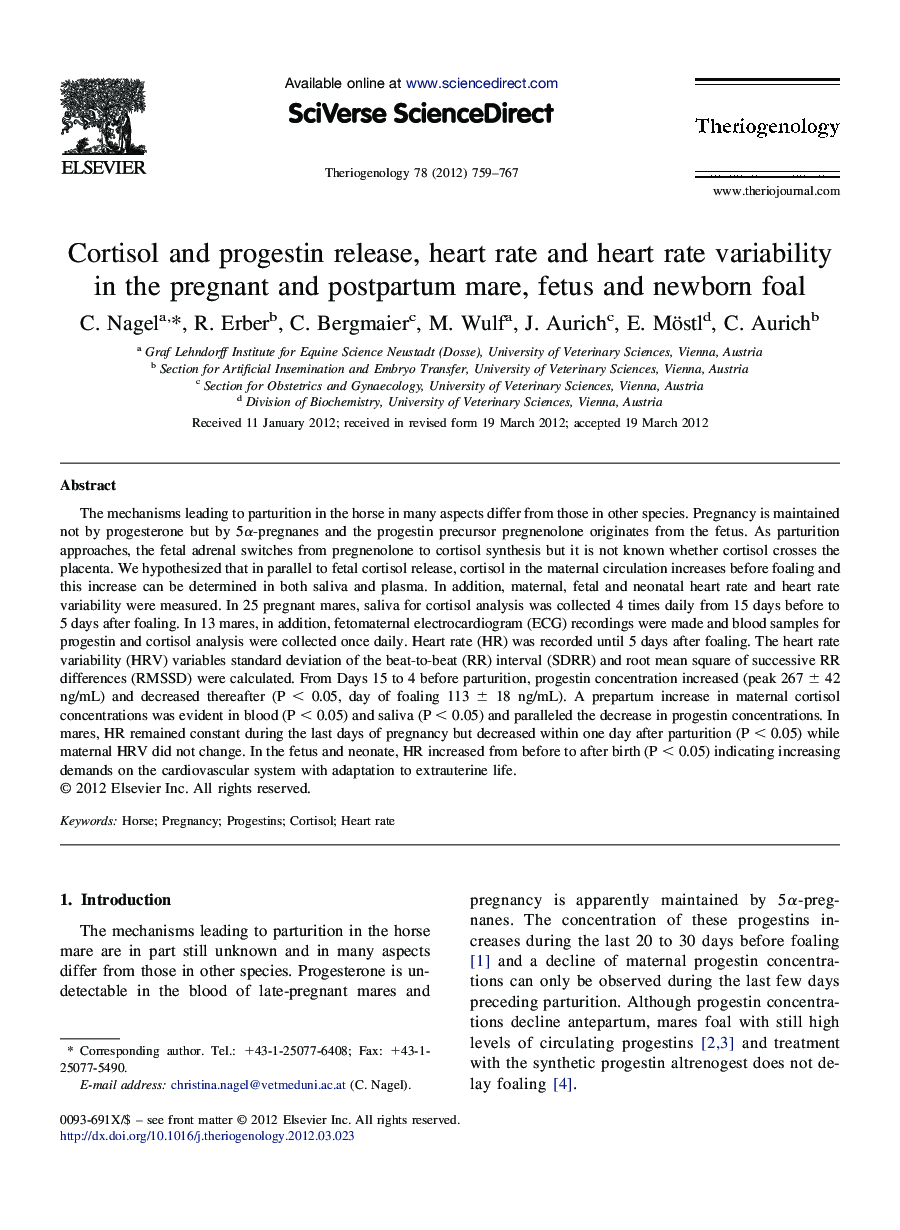| کد مقاله | کد نشریه | سال انتشار | مقاله انگلیسی | نسخه تمام متن |
|---|---|---|---|---|
| 10892219 | 1082095 | 2012 | 9 صفحه PDF | دانلود رایگان |
عنوان انگلیسی مقاله ISI
Cortisol and progestin release, heart rate and heart rate variability in the pregnant and postpartum mare, fetus and newborn foal
دانلود مقاله + سفارش ترجمه
دانلود مقاله ISI انگلیسی
رایگان برای ایرانیان
کلمات کلیدی
موضوعات مرتبط
علوم زیستی و بیوفناوری
علوم کشاورزی و بیولوژیک
علوم دامی و جانورشناسی
پیش نمایش صفحه اول مقاله

چکیده انگلیسی
The mechanisms leading to parturition in the horse in many aspects differ from those in other species. Pregnancy is maintained not by progesterone but by 5α-pregnanes and the progestin precursor pregnenolone originates from the fetus. As parturition approaches, the fetal adrenal switches from pregnenolone to cortisol synthesis but it is not known whether cortisol crosses the placenta. We hypothesized that in parallel to fetal cortisol release, cortisol in the maternal circulation increases before foaling and this increase can be determined in both saliva and plasma. In addition, maternal, fetal and neonatal heart rate and heart rate variability were measured. In 25 pregnant mares, saliva for cortisol analysis was collected 4 times daily from 15 days before to 5 days after foaling. In 13 mares, in addition, fetomaternal electrocardiogram (ECG) recordings were made and blood samples for progestin and cortisol analysis were collected once daily. Heart rate (HR) was recorded until 5 days after foaling. The heart rate variability (HRV) variables standard deviation of the beat-to-beat (RR) interval (SDRR) and root mean square of successive RR differences (RMSSD) were calculated. From Days 15 to 4 before parturition, progestin concentration increased (peak 267 ± 42 ng/mL) and decreased thereafter (P < 0.05, day of foaling 113 ± 18 ng/mL). A prepartum increase in maternal cortisol concentrations was evident in blood (P < 0.05) and saliva (P < 0.05) and paralleled the decrease in progestin concentrations. In mares, HR remained constant during the last days of pregnancy but decreased within one day after parturition (P < 0.05) while maternal HRV did not change. In the fetus and neonate, HR increased from before to after birth (P < 0.05) indicating increasing demands on the cardiovascular system with adaptation to extrauterine life.
ناشر
Database: Elsevier - ScienceDirect (ساینس دایرکت)
Journal: Theriogenology - Volume 78, Issue 4, 1 September 2012, Pages 759-767
Journal: Theriogenology - Volume 78, Issue 4, 1 September 2012, Pages 759-767
نویسندگان
C. Nagel, R. Erber, C. Bergmaier, M. Wulf, J. Aurich, E. Möstl, C. Aurich,